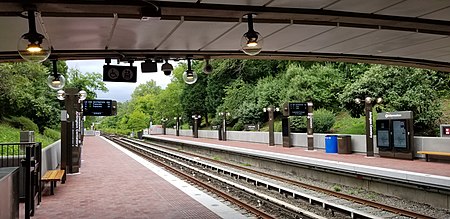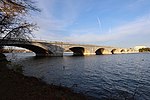Arlington Cemetery station

Arlington Cemetery is a side platformed Washington Metro station in Arlington, Virginia, United States. The station was opened on July 1, 1977, and is operated by the Washington Metropolitan Area Transit Authority (WMATA). The station provides service for only the Blue Line, and is located at the entrance to Arlington National Cemetery, underneath Memorial Drive. There is no public parking near the station except at the cemetery, which is reserved for cemetery visitors. It is the only station that closes earlier than the rest of the system, closing at 7 PM from October to March, and 10 PM from April to September.The station is one of three stations to be exclusively serviced by the Blue Line. The rest of the Blue Line's stations are shared with the Yellow Line to the south (except for two of the southernmost stations), and with the Silver Line and Orange Line to the north.
Excerpt from the Wikipedia article Arlington Cemetery station (License: CC BY-SA 3.0, Authors, Images).Arlington Cemetery station
Memorial Avenue, Arlington Rosslyn
Geographical coordinates (GPS) Address Nearby Places Show on map
Geographical coordinates (GPS)
| Latitude | Longitude |
|---|---|
| N 38.884583333333 ° | E -77.063083333333 ° |
Address
Arlington Cemetery
Memorial Avenue
20566 Arlington, Rosslyn
Virginia, United States
Open on Google Maps








